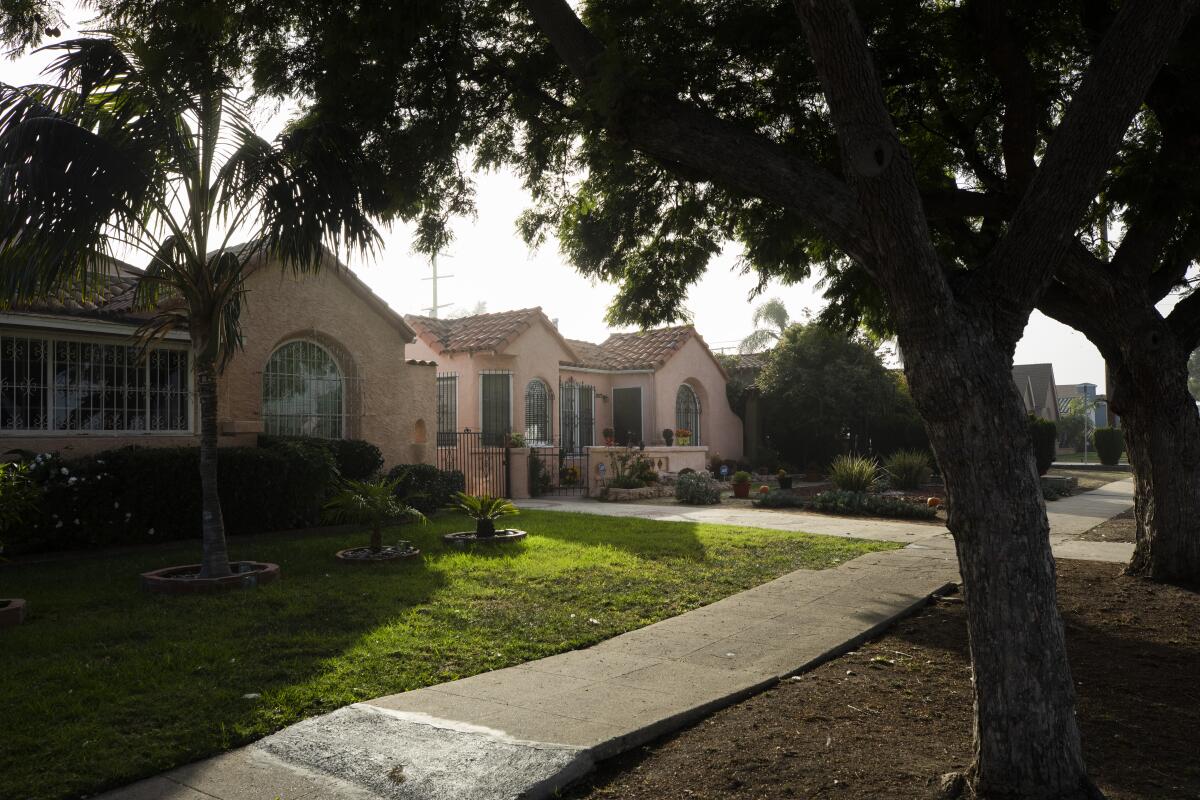Op-Ed: My South L.A. home is for sale on Zillow. But I’m not sure I’m ready to leave

- Share via
My home — a little 1920s bungalow in South Los Angeles off Slauson Avenue — is for sale. In the mornings, I check my email and Zillow reminds me that something I cherish is being offered up to strangers.
Dread gathers in my stomach. I’m not ready to leave. But two months ago, after ongoing talks with my husband Marcus, a real estate agent — It’s a seller’s market right now. Housing prices are at an all-time high, but experts are predicting another housing crash is just around the corner — I agreed to let him list our house to “test the market.”
“We’re not even going to consider it if we get offers less than $950,000 to a million,” Marcus said. I saw the dollar signs flashing in his eyes and I understood. He grew up city-poor (South Central L.A. during the ’70s and ’80s) and I grew up rural-poor (small-town Louisiana around the same time).
We bought our home for $400,000 in 2015. It was a stretch to qualify for the loan and buy the house from the Black woman who owned it. She said she was “quietly” testing the market and simultaneously trying to safeguard her house from investors who were on a roll flipping nearby homes at prices people like us cannot afford. “This area is changing so much,” she told us.
Now, when I look at our house listing, I feel like the investors she detested. That woman loved that we were a Black family moving into what has long been a working-class Black neighborhood, one where I can still enjoy vestiges of the Black Louisianans who migrated to the area during the Great Migration. (Camellia red beans and crawfish boudin are always at the corner liquor store.)
This salmon-colored stucco is not our dream home. It backs up to an alley that backs up to a stretch of Slauson peppered with old storefronts — some boarded up and graffitied. It is situated on a block that Marcus, who got caught up in gang life when he was a young teen, calls “ground zero” of the Rollin’ 60s Neighborhood Crips.
While the area continues to gentrify, its past sometimes rears its ugly head. Just a few blocks away is where the rapper and entrepreneur Nipsey Hussle was killed outside his store, The Marathon Clothing, in 2019. I was sitting on my living room floor trying to write when police helicopters swarmed overhead, drawing us out of our houses.
At memorials surrounding Nipsey’s store, I ran into former students. In the early 2000s, I used to teach at a high school on the corner of Crenshaw and Slauson, where we dissected Langston Hughes’ poem “Harlem,” which begins: “What happens to a dream deferred?” Inspired by Nipsey’s transformation story, these young people pledged to carry on his dream of community empowerment.
It was then that Marcus first broached the topic of moving, when home prices were soaring but interest rates were not. Did we really want to continue raising our then-12-year-old son here, where quality food options are still anemic, schools continue to languish and old gang wars might reawaken?
But I wanted then, and want now, to stay and be part of the new progress here. The coming Hyde Park Metro station has helped drive up home values. What excites me is homegrown progress. The closest Ralphs, the last place to provide fresh produce in the Hyde Park neighborhood, shut down last year. Now L.A. native Olympia Auset is opening an organic grocery store, Süprmarkt. During one of our recent walks, my 15-year-old son and I passed Auset’s Slauson location and saw volunteers painting the exterior white. “When school’s out, I want you to come back and help them,” I said.
“What a gem this neighborhood is!” a real estate agent, showing a $900,000-house around the corner just before the pandemic, said to me. “Driving down Slauson, you’d never know.”
Until there’s police activity again, until the Citizen or Nextdoor apps light up with bad news, which has increased these last two years. “It’s like the neighborhood hasn’t caught up to their million-dollar investments yet,” Megan, my neighborhood Zumba buddy, said the other day.
In this time of COVID-19, inflation and rising homelessness, it’s hard to imagine a future where the whole neighborhood can “catch up.”
“Girl, do not sell your house,” my neighbor Jasmin said after I told her Marcus had listed it.
“I don’t really want to,” I said. And despite the lure of some financial freedom, Marcus doesn’t either. He hasn’t shown it to any of the people who’ve reached out. And as interest cools, he’s talking again about some plans for the house — and the community.
Back in school for a bachelor’s degree in astrophysics, a wish he’s harbored for years, Marcus’ goal is to open a science and technology training center for South L.A. kids. And he wants to find a way to build the kind of financial success that will give his own sons opportunities he did not have. This little house off Slauson is where these and other dreams found a voice. I believe a house hears our dreams, even in the midst of plague and civil unrest and recession, cocooning them until we can bring them to fruition — if we can withstand transient temptation.
Cassandra Lane is author of a memoir, “We Are Bridges,” and a contributor to the forthcoming anthology “Writing the Golden State: The New Literary Terrain of California.”
More to Read
A cure for the common opinion
Get thought-provoking perspectives with our weekly newsletter.
You may occasionally receive promotional content from the Los Angeles Times.










